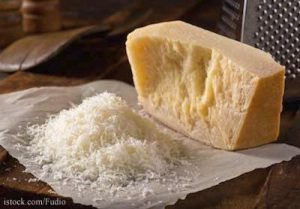A cheese manufacturer went bankrupt and was charged in criminal court for food labeling violations over the manufacturing of Parmesan cheese. Almost three years ago, the FDA sent a warning letter to Castle Cheese in Pennsylvania, telling them that their products are adulterated because their Parmesan cheese doesn’t actually contain Parmesan cheese. In addition, the facility was adding cellulose, or wood pulp (this was the sensational news headline part) to extend the cheese.
 Parmesan cheese is strictly regulated by its official definition. Parmesan cheese should be made from Parmesan cheese. That sounds logical, but some manufacturers substitute a less expensive cheese, and add filler to reduce their costs even more.
Parmesan cheese is strictly regulated by its official definition. Parmesan cheese should be made from Parmesan cheese. That sounds logical, but some manufacturers substitute a less expensive cheese, and add filler to reduce their costs even more.
Cellulose is technically wood, but it won’t hurt you and is used in other foods to add bulk to the product, provide structure, prevent clumping, and reduce breakage. It also adds fiber to the product, which more Americans should consume more of. Sodium carboxymethyl cellulose is on the generally regarded as safe (GRAS) list as a food additive. But calling it “wood” is certainly attention-grabbing.
The warning letter sent to Castle Cheese states that they used a processed cheese-like base instead of milk to make the cheese. In addition, other varieties of cheese were used instead of the cheeses declared on the product labels. Cellulose and starch were used to increase the weight of the cheese.
In addition, their International Packing Parmesan Cheese, Romano 100% Grated Cheese, and 100% Grated Parmesan Cheese were “a mixture of trimmings of various cheese and other ingredients.” And, the Parmesan cheese products did not contain any Parmesan cheese, but were made from mozzarella, Swiss, white cheddar, and cellulose.
If that wasn’t bad enough, investigations found positive Listeria tests in the facility, and the firm did not perform speciation testing as a follow up to determine whether or not that bacteria was Listeria monocytogenes. That step is necessary, since there is zero tolerance for Listeria monocytogenes in ready-to-eat food products.
Castle Cheese isn’t the only manufacturer that is adding cellulose to Parmesan. According to Bloomberg Business, which bought packaged grated cheeses and had them tested, Walmart’s Great Value 100% Grated Parmesan Cheese has 7.8% cellulose. Essential Everyday 100% Grated Parmesan Cheese sold at Jewel-Osco has 8.8% cellulose. And Whole Foods and Kraft Parmesan cheeses have cellulose added that are within the acceptable level, which is about 2 to 4%.
Castle President Michelle Myrter is allegedly going to plead guilty this month to the criminal charges. She could spend up to a year in prison and may have a $100,000 fine levied against her.





Question isn’t the amount of cellulose on the cheese. But what is the wood cellulose used on the cheese. The type used for ice cream and latex paint are pure form. Meaning if you burn it there is no ashes. Now burn the wood pulp used for copy paper or newspaper and see what it looks like.
The FDA regulates the cellulose that is added to food products. It’s either microcrystalline cellulose, which is usually listed on labels as MCC or cellulose gel, carboxymethyl cellulose, or powdered cellulose. It’s not harmful and isn’t digestible.